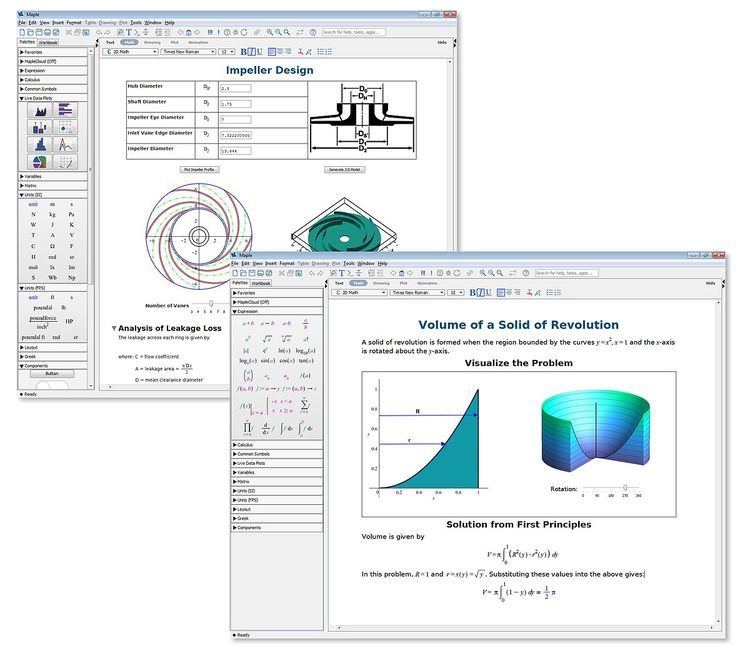Initial release 1982 | ||
 | ||
Stable release 2016 / March 2, 2016 (2016-03-02) | ||
Maple is a symbolic and numeric computing environment, and is also a multi-paradigm programming language.
Contents
- Core functionality
- Architecture
- History
- Features
- Examples of Maple code
- Integration
- Determinant
- Series expansion
- Solve equation numerically
- Plotting of function of single variable
- Plotting of function of two variables
- Animation of functions
- Laplace transform
- Fourier transform
- Integral equations
- Use of the Maple engine
- References
Developed by Maplesoft, Maple also covers other aspects of technical computing, including visualization, data analysis, matrix computation, and connectivity.
A toolbox, MapleSim, adds functionality for multidomain physical modeling and code generation.
Core functionality
Users can enter mathematics in traditional mathematical notation. Custom user interfaces can also be created. There is support for numeric computations, to arbitrary precision, as well as symbolic computation and visualization. Examples of symbolic computations are given below.
Maple incorporates a dynamically typed imperative-style programming language which resembles Pascal. The language permits variables of lexical scope. There are also interfaces to other languages (C, C#, Fortran, Java, MATLAB, and Visual Basic). There is also an interface to Excel.
Maple supports MathML 2.0, a W3C format for representing and interpreting mathematical expressions, including their display in Web pages.
Architecture
Maple is based on a small kernel, written in C, which provides the Maple language. Most functionality is provided by libraries, which come from a variety of sources. Most of the libraries are written in the Maple language; these have viewable source code. Many numerical computations are performed by the NAG Numerical Libraries, ATLAS libraries, or GMP libraries.
Different functionality in Maple requires numerical data in different formats. Symbolic expressions are stored in memory as directed acyclic graphs. The standard interface and calculator interface are written in Java.
History
The first concept of Maple arose from a meeting in November 1980 at the University of Waterloo. Researchers at the university wished to purchase a computer powerful enough to run Macsyma. Instead, it was decided that they would develop their own computer algebra system that would be able to run on lower cost computers. The first limited version appearing in December 1980 with Maple demonstrated first at conferences beginning in 1982. The name is a reference to Maple's Canadian heritage. By the end of 1983, over 50 universities had copies of Maple installed on their machines.
In 1984, the research group arranged with Watcom Products Inc to license and distribute the first commercially available version, Maple 3.3. In 1988 Waterloo Maple Inc. was founded. The company’s original goal was to manage the distribution of the software. Eventually, the company evolved to have an R&D department where most of Maple's development is done today with the rest done at university research labs worldwide including: the Symbolic Computation Laboratory at the University of Waterloo and the Ontario Research Centre for Computer Algebra at the University of Western Ontario.
In 1989, the first graphical user interface for Maple was developed and included with version 4.3 for the Macintosh. X11 and Windows versions of the new interface followed in 1990 with Maple V. In 1992, Maple V Release 2 introduced the Maple "worksheet" that combined text, graphics, and input and typeset output. In 1994 a special issue of a newsletter created by Maple developers called MapleTech was published.
In 1999, with the release of Maple 6, Maple included some of the NAG Numerical Libraries. In 2003, the current "standard" interface was introduced with Maple 9. This interface is primarily written in Java (although portions, such as the rules for typesetting mathematical formulae, are written in the Maple language). The Java interface was criticized for being slow; improvements have been made in later versions, although the Maple 11 documentation recommends the previous (“classic”) interface for users with less than 500 MB of physical memory.
Between the mid 1995 and 2005 Maple lost significant market share to competitors due to a weaker user interface. In 2005, Maple 10 introduced a new “document mode”, as part of the standard interface that it has been further developed over the following years.
In September 2009 Maple and Maplesoft were acquired by the Japanese software retailer Cybernet Systems.
Features
Features of Maple include:
Examples of Maple code
Sample imperative programming constructs:
Simple functions can also be defined using the "maps to" arrow notation:
Integration
Find
Answer:
Determinant
Compute the determinant of a matrix.
Series expansion
series(tanh(x),x=0,15)Solve equation numerically
High order polynomial equation
Plotting of function of single variable
Plotting of function of two variables
Animation of functions
Laplace transform
Fourier transform
Integral equations
Find functions
Use of the Maple engine
The Maple engine is used within several other products from Maplesoft:
Listed below are third-party commercial products that no longer use the Maple engine:
